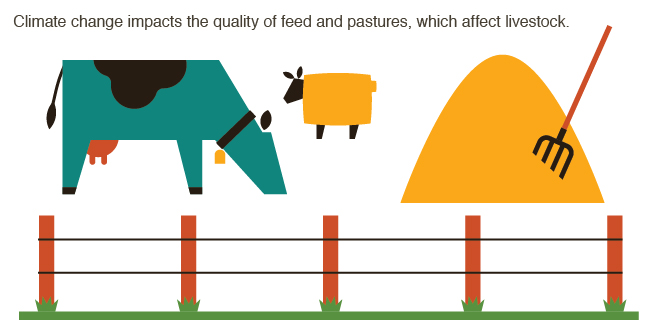Livestock

Facts
- Climate change will affect livestock production by altering the quantity and quality of feed available for animals. It is also expected to change the species composition (and hence biodiversity and genetic resources) of grasslands and affect the digestibility and nutritional quality of forage (Thornton et al. 2009).
- As long as water requirements are met, increases in temperature, CO2 concentration and N-deposition may increase primary production in pastures by promoting early season growth and enabling the cultivation of more-productive forage species. This will allow farmers to keep high-output livestock breeds (Thornton 2010).
- Climate change will have a greater impact on grassland-based systems than on cropland because growing conditions on croplands are more easily manipulated (e.g. through irrigation and/or wind protection) (FAO 2006 p. 47).
- Climate change will also directly impact animals through increased heat stress, changes in water availability (with droughts affecting livestock in particular) and a greater range of livestock diseases and disease carriers (Thornton et al. 2009).
- Body temperatures greater than 45–47 °C. are lethal for most livestock species. Although many local breeds in the tropics and subtropics are relatively well adapted to high temperatures, high-output breeds from temperate regions are not (Thornton 2010).
- Relatively few studies have looked at the likely impact of climate change in tropical regions; far more have looked at likely impacts in temperate regions. Predictions of future impacts of climate change in the tropics are therefore less certain (Easterling et al. 2007).
- The size of ‘livelihood transition zones’ in Africa, defined as areas with less than 90 reliable crop growth days per year (making even maize cultivation impossible), will increase significantly by 2050. Farmers in these areas may have to switch to integrated crop–livestock systems or to pure livestock systems (Jones and Thornton 2008).
- Climate change could also affect the distribution of vector-borne livestock diseases as a result of shifts in the geographical ranges of ticks, mosquitoes, flies and other vectors. Diseases affected by these changes include East Coast fever, babesiosis, anaplasmosis and trypanosomiasis (Thornton and Cramer 2012).
- Higher income regions, such as Europe and North America exhibit lower emission intensities per unit livestock production when compared with production in Africa, Asia, and Latin America. So, the greatest technical potential for reducing emission intensities lies in these low income regions. However, intensification practices must be balanced against local resource constraints and existing livelihood strategies (Herrero et al., 2013).
Sources and further reading
- Easterling WE, Aggarwal PK, Batima P, Brander KM, Erda L, Howden SM, Kirilenko A, Morton J, Soussana J-F, Schmidhuber J, Tubiello FN. 2007. Food, fibre and forest products. In Parry ML, Canziani OF, Palutikof JP, van der Linden PJ, Hanson CE, eds. Climate change 2007: Impacts, adaptation and vulnerability. Contribution of Working Group II to the Fourth Assessment Report of the Intergovernmental Panel on Climate Change. Cambridge, UK: Cambridge University Press. pp. 273–313. (Available from https://www.ipcc.ch/pdf/assessment-report/ar4/wg2/ar4-wg2-chapter5.pdf)
- [FAO] Food and Agriculture Organization of the United Nations. 2006. Livestock’s long shadow. Rome: FAO. (Available from http://www.fao.org/docrep/010/a0701e/a0701e00.HTM) (Accessed on 6 November 2013)
- Jones PG, Thornton PK. 2008. Croppers to livestock keepers: livelihood transitions to 2050 in Africa due to climate change. Environmental Science & Policy 12(4):427–437. (Available from http://dx.doi.org/10.1016/j.envsci.2008.08.006)
- McCarthy JJ, Canziani OF, Leary NA, Dokken DJ, White KS, eds. 2001. Climate change 2001: Impacts, adaptation, and vulnerability. Contribution of Working Group II to the Third Assessment Report of the Intergovernmental Panel on Climate Change. Cambridge, UK: Cambridge University Press. (Available from http://www.grida.no/publications/other/ipcc_tar/?src=/climate/ipcc_tar/wg2/index.htm)
- Morton JF. 2007. The impact of climate change on smallholder and subsistence agriculture. PNAS 104(50):19680–19685, doi: 10.1073/pnas.0701855104.
- Nelson GC, Rosegrant MW, Koo J, Robertson R, Sulser T, Zhu T, Ringler C, Msangi S, Palazzo A, Batka M, Magalhaes M, Valmonte-Santos R, Ewing M, Lee D. 2009. Climate change. Impact on agriculture and costs of adaptation. Washington, DC: International Food Policy Research Institute. (Available from http://www.ifpri.org/sites/default/files/publications/pr21.pdf)
- Thornton PK. 2010. Livestock production: recent trends, future prospects. Philosophical Transactions of the Royal Society B: Biological Sciences 365(1554):2853–2867. doi:10.1098/rstb.2010.0134.
- Thornton P, Cramer L, eds. 2012. Impacts of climate change on the agricultural and aquatic systems and natural resources within the CGIAR’s mandate. CCAFS Working Paper 23. Copenhagen: CGIAR Research Program on Climate Change, Agriculture and Food Security (CCAFS). (Available from http://cgspace.cgiar.org/handle/10568/21226) (Accessed 5 November 2013)
- Thornton PK, Gerber P. 2010. Climate change and the growth of the livestock sector in developing countries. Mitigation and Adaptation Strategies for Global Change 15(2):169–184. (Available from http://dx.doi.org/10.1007/s11027-009-9210-9)
- Thornton P, Herrero M. 2010. The inter-linkages between rapid growth in livestock production, climate change, and the impacts on water resources, land use, and deforestation. Washington, DC: World Bank. (Available from https://openknowledge.worldbank.org/handle/10986/9223) (Accessed on 13 November 2013)
- Thornton P, van de Steeg J, Notenbaert M H, Herrero M. 2009. The impacts of climate change on livestock and livestock systems in developing countries: A review of what we know and what we need to know. Agricultural Systems 101: 113–127. (Available from http://dx.doi.org/10.1016/j.agsy.2009.05.002)
- Thornton P, van der Steeg J, Notenbaert A, Herrero M. 2013. Climate change: do we know how it will affect smallholder livestock farmers? The Futures of Agriculture: Brief No. 43. Rome: Global Forum on Agricultural Research. (Available from http://www.egfar.org/sites/default/files/files/Philip%20Thornton_Livestock_Brief%2043_Final.pdf) (Accessed on 13 November 2013)